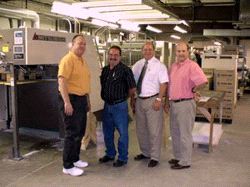Offset Printing
Green Ways in the Green Mountain State

Monday 14. July 2008 - New Mitsubishi press reflects Springfield Printing's commitment to a healthy environment
Many progressive printing companies in Vermont have been leading the green wave for years. For one family-owned, Green Mountain state commercial print shop, green printing comes second nature.
Concern for the environment drives Springfield Printing Corp.’s production practices. The North Springfield-based firm holds the chain-of-custody certification from the Forest Stewardship Council (FSC) and follows strict recycling procedures in its preparation, printing and finishing operations.
“Being in Vermont, our customers really demand that we walk that walk,” said co-owner Mark Sanderson. “We work hard to do our part for the environment.”
Springfield Printing achieves sustainable printing results without having to make a tradeoff in terms of quality, cost or time. The company undertook a major investment in the future of green printing when it acquired a Mitsubishi Diamond 3000LX wide stock range press with aqueous coater and SimulChanger. Installed to replace a 16-year-old Mitsubishi press, the six-color, 40-inch Diamond 3000LX is slashing makeready waste and chemical usage.
“The environmental aspects of the press were very important to us,” Sanderson said. “In its first two months in operation, it cut the number of makeready sheets in half. The washing systems have significantly reduced rag usage.”
Continued emphasis on environmentally sensitive practices has drawn the attention of Vermont’s chief executive. Governor Jim Douglas was among 70 guests who attended an open house held at Springfield Printing in April to introduce existing and prospective customers to the Diamond 3000LX.
Printing is a Sanderson family tradition. Mark and his brother, Bruce, are the third generation of Sandersons to earn their livings from printing. Their father, Robert, and grandfather, Gordon, owned a print shop south of Boston in the 1940s and 1950s. Robert bought Springfield Printing in 1967 and moved to central Vermont, about an hour north of the Massachusetts state line. Today, Mark serves as president of Springfield Printing; Bruce is vice president of sales and marketing.
Established in 1878, Springfield Printing employs 43 people at its 25,000-square-foot plant, which runs two shifts a day. Annual sales are at $5.5. million. Mark Sanderson said the company has targeted $7 million in sales volume as a near-term goal.
Springfield Printing serves clients in the New England market with what the company calls “the Vermont-friendly attention they deserve.” The recreation and tourism industries are big consumers of Springfield Printing’s high-end color materials.
“We do a lot of brochures, marketing pieces, trail maps and associated collateral for ski resorts,” Sanderson said. “We also print for the academic community and high-end manufacturers.”
As is the case with many commercial printers these days, the norm for run lengths is 10,000 to 20,000 sheets, though runs can surpass several hundred thousand sheets, according to Sanderson.
In addition to the Diamond 3000LX, the sheetfed lineup includes two more 40-inch presses (a five-color perfector and a two-color straight press) and a two-color, 20-inch press. An HP Indigo 5000 digital press has opened up opportunities in the printing of variable data direct mail campaigns and personalized one-to-one marketing pieces. Springfield Printing has expanded its in-house mailing capabilities and implemented cross-media programs, including personalized URLs (PURLs), to capture a larger share of these types of projects.
Packaging is another business area that Springfield Printing is actively developing as a result of installing the Diamond 3000LX. The press prints on text paper, synthetic substrates and folding carton stock up to 40-point thickness.
“The wide stock range capabilities will create opportunities for us in packaging printing,” Sanderson said.
As a green printer, Springfield Printing constantly looks for ways to make its print projects and the Earth look better.
“Ninety-seven percent of our jobs are printed with soy-based inks,” Sanderson said. “Press and bindery paper waste, corrugated cartons, metal printing plates and metal items used in the production process are recycled. We take part in a program in which our vendors collect and reuse the wooden pallets that come into the shop. All of the plastic drums that contain aqueous coatings are picked up, shredded and made into other containers.”
Sanderson pointed to several features on the press that are responsible for reducing its environmental footprint.
“The systems for blanket, ink roller and back cylinder wash-up are all automated and use cloth media with low-VOC (volatile organic compounds) washing solution,” he said. “We estimate that we will have 50,000 to 60,000 fewer rags a year that won’t need to be washed.”
Sanderson added that applying water-based coatings takes the place of oil-based varnishes.
Makeready automation is reducing the amount of time and waste materials expended to achieve full color. At Springfield Printing, SimulChanger, Mitsubishi’s fully automated system for simultaneous plate changing, has repeatedly changed all six plates on the Diamond 3000LX in 58 seconds. An X-Rite automatic scanning densitometer helps get jobs ready in a fraction of the time they previously required. Press operators can turn their attention to quality control and solving production issues that arise.
“With our older press, a job changeover on a typical six-color job was completed in approximately one hour,” Sanderson said. “The Diamond 3000LX completes the same task in 30 minutes. We also are seeing the number of makeready sheets go way down. Historically, we allocated 1,000 sheets for a four-over-four job. Now we are doing 500-sheet makereadies on similar jobs, saving approximately 100,000 pounds of paper in the process. We are confident we can reduce those makereadies further to 300 sheets on this press.”
